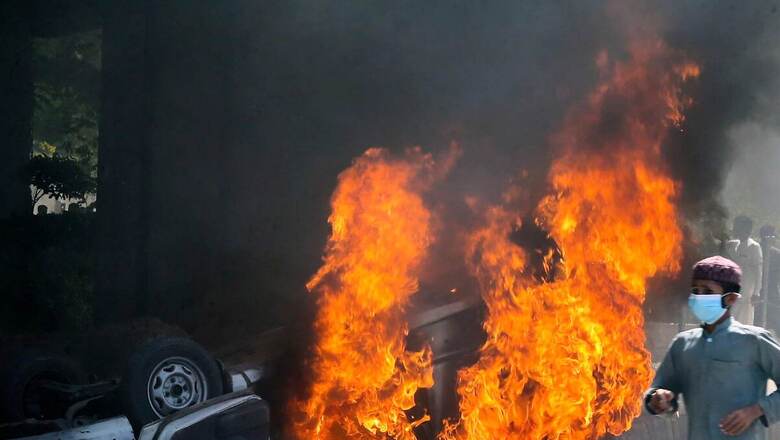
views
The emerging political crisis in Pakistan has seen violent protests across the country against the current ruling civilian government and its military.
Although the army of Pakistan has conveyed that it has no intention of imposing yet another martial law after former Prime Minister Imran Khan’s arrest and his immediate release by Supreme Court recently, the country’s chequered past indicates that the possibility of Pakistan going under yet another military rule can’t be ruled out easily, especially when the army is being challenged directly.
Protests after Khan’s arrest saw military premises being targeted. Protesters stormed into the Pakistan army headquarters in Rawalpindi.
FOURTH AND FIFTH MARTIAL LAWS
The last time the country saw martial law imposed was 16 years ago, in 2007, by Pervez Musharraf who began his term of ruling the country with it in 1999. In a military coup, Musharraf, then army chief of Pakistan, removed the country’s Prime Minister Nawaz Sharif on October 12, 1999 and on October 14, 1999, declared martial law. He suspended the country’s constitution and dissolved its parliament.
Musharraf was Sharif’s choice to head the army, but according to General (Retired) Ziauddin Butt’s conversation with Pakistan newspaper Dawn, Musharraf’s first aim after his appointment as the army chief in October 1998 was Pakistan’s next military coup. Musharraf is considered the chief architect of the 1999 Kargil war that Pakistan badly lost. It is said Musharraf imposed the limited-scale conflict on India without approval of the civilian government headed by Sharif.
Sharif got a hint that Musharraf was going to overthrow his government. Before Musharraf could make a move, he was sacked by the civilian government and a new army chief was appointed. The country’s army and Musharraf swiftly launched the counter move, toppled the government, and arrested the prime minister, later exiling him to Saudi Arabia.
In doing so, Musharraf revisited the country’s controversial past of its military chiefs eliminating electorally won civilian governments and declaring themselves, first the chief martial law administrator and then the president of the nation.
Almost two years later, in June 2001, he elevated himself to become the country’s president. In 2002, he imposed on the country a heavily amended constitution that extended his term for another five years. All this while, he was also the head of its military.
His re-election bid in 2007 is another story of how the military of the country has made constitutional institutions lame and fragile.
The Supreme Court opposed his re-election bid, as the country’s parliament was going to elect a president who continued to remain its army chief, which was constitutionally illegal. In response, Musharraf, in his first step, tried to sack the chief justice of the country, but failed. After the top court put a stay on his re-election bid in October 2007, in his second step, he declared a mini martial law in the country. The state of emergency declared in the country saw its constitution dismissed, and the country’s chief justice and other top court judges removed. To validate his re-election bid, in the third step, he installed a puppet judiciary. Result: His re-election outcome was accepted.
Musharraf resigned from the army and became a civilian president after it. Facing impeachment, he was forced to resign on August 18, 2008.
He was in the office for 3,234 days or eight years and 10 months.
FIRST MARTIAL LAW: THE BEGINNING
Pakistan was born in 1947. The country adopted its constitution after nine years, on February 29, 1956. The rulebook to run the country was enforced on March 23, 1956. After spending nine years on making the constitution, Pakistan saw its abrogation within 29 months of its implementation, on October 7, 1958, by then president Iskander Mirza, who, it is said, colluded with the army to impose emergency in the country. Political activities were banned. National and provincial assemblies were dissolved. Pakistan was officially put under martial law with its army chief General Mohammad Ayub Khan as chief martial law administrator.
Within 20 days of the abrogation, Pakistan saw its first military coup. Ayub Khan, who already had declared himself as the field marshal of the country, went on to depose Iskander Mirza on October 27, 1958, to become the country’s president.
The first martial law officially lasted for 44 months and was replaced by a presidential form of government with Ayub Khan being the country’s supreme leader. The military ruler gave Pakistan another constitution in 1962 that was presidential in nature, concentrating all powers in his position. Khan believed Pakistan was not ready for a parliamentary democracy system. Political parties were banned initially. Leaders were either banned or exiled. Civil servants were replaced with army officers. Later, Ayub Khan came up with his own political party, the Convention Muslim League.
Under his presidency, Pakistan saw the next phase of emergency imposed, when it declared a war on India over Kashmir in 1965. Result: Miscalculation of its own and India’s military strengths left Pakistan defeated and embarrassed. Seeing his popularity going down, he decided not to contest the 1970 presidential election and instead chose General Yahya Khan, who was the army chief since 1996, to replace him as the next president of the country.
Ayub Khan ruled the country till March 1969, which is 3,803 days or 10 years and four months.
SECOND MARTIAL LAW
The country’s second martial law was imposed immediately after Ayub Khan’s resignation from the presidential office, with General Yahya Khan’s elevation as the country’s president on March 25, 1969. He ruled the country till December 1971 as its president, army chief and martial law administrator.
Yahya Khan favoured elections in the country with a new constitution. He declared he will rule the country till the next general elections. Abrogating Ayub Khan’s 1962 constitution, his administration restored Pakistan’s four original provinces — Punjab, Sind, North-West Frontier Province and Balochistan.
Under his rule, Pakistan saw its worst military defeats so far after it fought another war with India. Soundly defeated, the country was divided into two parts with East Pakistan declaring its independence as Bangladesh in 1971.
Facing two big war losses against India in just six years, when army was driving the country, Yahya Khan and the country‘s army had no other option, but to leave the political system for some time. He handed over the country’s presidency to Pakistan People’s Party (PPP) leader Zulfikar Ali Bhutto. Under Bhutto’s leadership, Pakistan saw its current constitution adopted in 1973. It changed the country’s political system again to parliamentary in nature. The constitution was adopted on August 14, 1973, with Bhutto becoming the country’s prime minister.
Yahya Khan ruled the country for 1,001 days or almost two years and nine months.
THIRD MARTIAL LAW
Pakistan’s third martial law was declared on July 5, 1977, by Pakistan army chief General Zia-ul-Haq. He took the reins of the country and put prime minister Zulfikar Ali Bhutto in house arrest over allegations of election fraud. Zia-ul-Haq was Bhutto’s choice to head the Pakistan army. The electoral fraud led to widespread violence in the country post the March 1977 parliamentary elections.
National and provincial assemblies were dissolved. While declaring the martial law, he assured the nation of holding elections in 90 days, but soon declared himself the next president, in September 1978. Next year, all political parties and leaders were targeted and banned. Bhutto was found guilty and was hanged to death on April 4, 1979.
Pakistan’s governance and political system was given a religious shape through his Islamization mandate. Minorities were specifically targeted. In February 1985, President Zia allowed elections to national and provincial assemblies, on the condition that no political parties were allowed to contest. At the same time, he was declared the country’s president for another five years. A Sindhi politician, Muhammad Khan Junejo, was chosen as the prime minister when the martial law was lifted in December 1985.
In May 1988, President Zia again dissolved the national and provincial assemblies, alleging corruption and disloyalty. Promising an election soon, he formed a caretaker government, declaring himself as its head.
President Zia was in office till August 17, 1988, heading the country and its army, before dying in a plane crash. He ruled the country for 3,624 days or nine years and 11 months.
COUNTRY’S HISTORY ‘MARTIALLED’
A country just 75 years young has seen three constitutions implemented. The country’s rulebook was abrogated twice and suspended multiple times. Military dictators heavily amended it to suit their own purpose. The country has seen direct rule of military dictators for around 32 years with five martial laws and almost no political activities. National and provincial assemblies were dissolved multiple times.
The military dictators pushed Pakistan to fight three wars with India. For a Pakistani citizen, the country lost all, along with a big chunk of territory in the form of Bangladesh.
A country which was born in 1947 from the world’s largest democracy, India, needed a clear chapter for its growth story, like India. The story, however, has been hijacked and martialled not by outsiders, but by the Pakistan military.
Growth of a country means political stability, which has been totally absent in Pakistan, thanks to its martial laws.















Comments
0 comment